
BIOREADER® 7000 -F-z-i
Versatile, Inverted high resolution Zoom
Fluoro/VIS reader, micro + macro mode with innovative power LED fluoro excitation
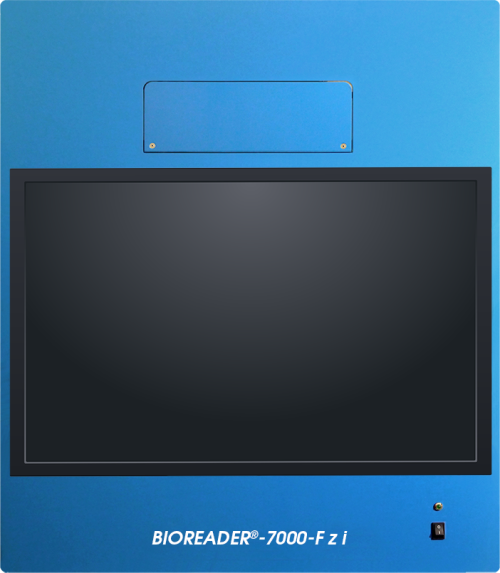
Fluoro/VIS reader, micro + macro mode with innovative power LED fluoro excitation
The BIOREADER® 7000 -F-z-i is particularly suitable for the analysis of live cells in suspension and adherent cells.
This Bioreader® 7000 -F z i provides an automatic zoom range for full field of view 35 - 100 mm Petridish and 6 - 384 well plates.
Providing a resolution of: 30 - 2000 µm for FOCI, 100 - 5000 µm for Plaques or 50 - 2000 µm cell clones.
Model variants:
Fluoro filtersets installed Max. VIS light possible
Alpha 1 3
Beta 2 3
Gamma 3 3
Delta 6 3
All Bioreader® 7000 -F-z-i model variants can be upgraded to max. 8 Fluoro filtersets.
Independence
Bioreader® and EazyReader® operate with all commonly used Elispot/Fluorospot/Plaque/Fluoro-Plaque/CFU assays.
You can choose among all major assay manufactures.
Tests of antiviral substances
This Bioreader® and EazyReader® support testing and development of antiviral substances.
Example#1: The automatic analyses of Plaque reductions assay.
This assay applies diluted doses of a -possibly- antiviral drug into multiwell plates. The Bioreader automatically observes its capability to suppress the formation of plaques (-holes-) in the bacterial lawn.
The ‘Plaque reductions neutralization test’ (PRNT) is a variation of this test. It is an attempt to find an antibody that neutralizes a specific virus. This is a very valuable tool in antiviral vaccine research.
Examplel#2: The automatic evaluation of the Yield reduction assay
In several steps of operation cells are infected in presence of variable doses of a possibly antiviral drug substance.
Thereafter the virus titer is determined in the liquid by use of the plaque or TCID50 assay with of the Bioreader®.
The titer is calculated as the quotient of the positive cells/all cells, taking in account the virus dilution factor and the volume of the inoculum.
- Automatic of all mechanical functions incl. focus, zoom, aperture.
- 8 times filter changer.
- Upgrade option from model alpha to gamma and delta.
- Dual telecentric illumination for better cytokine quantification.
- Automatic zoom lens for 6-48 well plates and/or Petri dishes.
- Fixed focus lens for 96-384 well plates or Petri dishes.
- Fluoro/UV LED excitation plus 3 types of white light LED illuminations.
- Hardware is automatically controlled by software measure setup (GxP-locked).
- No mercury or deuterium lamps required, thus 50T hourly lifetime.
- Improved suppression of auto-fluorescence, cluster separation, well recognition and cytokine volume quantification.
- Brand-new generation 7 makes it significant faster and more precise regarding positioning.
- Single click export to PDF, Microsoft Office® applications.
- Front loader, automatic door.
- Dual tele-centric illumination.
- Loud speaker and interactive training program.
- Excel/Word/Power Point and LIMS export capabilities.
- Suitable for research purpose.
- High contrast/low noise cameras 5-41 MPixel available.
- Optional automation with plate 'feeding system'.
- DQ/IQ/OQ/PQ documention possible.
- 12 months warranty.
- EC declaration of conformity and EMC certificate.

- Innovative Bioreader® and EazyReader® software combines ‘easy of use’ and versatility and flexibility.
- Scan, analyze and overlay live time.
- Creates up to 7 images for each well simultaneously during the scan.
- ‘Profiling’ app helps to create user independent measure protocols for Elispot beginners and references for experts.
- Verified in collaborative studies.
- Export options and reports with all scalable images and results even in one file.
- Customer specific export and report templates.
- Video clips and content specific help files.
- Qualified installation and training with each instrument.
- On-site or internet remote services and support.
- ‘Classified’ measure protocols ‘history’ tracking and comparison tools.
- User specific plates, Studies/projects, plate layouts/designs and measure protocols prevent from mix-up.
- More accurate ‘cytokine quantification’ based on the patented ‘photometric’ dual illumination system.
- Optional software features:
- 21 CFR part 11 based software module available
Weight
Dimension
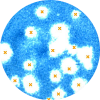
Plaque assay: very bright plaques in 24 well plate
Cells were infected and covered with an overlay. Cells stained with CV survive. Unstained cells were killed by the virus.

Foci assay: total well view
"The focus forming assay (FFA) is a variation of the plaque assay, but instead of relying on cell lysis in order to detect plaque formation, the FFA employs immunostaining techniques using fluorescently labeled antibodies specific for a viral antigen to detect infected host cells and infectious virus particles before an actual plaque is formed."
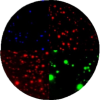
Fluorospot 1-4 colors
Multi Fluoro Color Reader,
best for Elispot and FluoroSpot
Applies ‘local neighborhood processing’ in order to compensate for uneven background on fluoro plates. This way the spot volume is quantified, independent from the local background.
Why use Fluorospot?
Enzymatic Elispot labeling
• allows to label 1-2 cytokines per cell simultanously.
• If you are interested to see ‘double secreting’ cells the stain of two cells in neighborhood may overlap. So, It is not clear if two cells are overlapping or one cells is really secreting two different cytokines (see below left).
‘Fluorospot’ labeling
Allows to label -a theoretical unlimited number different- cytokines. Because excitation for each cytokine is applied -one after the other-, decisions for double secreting cells is clearly.
One Image is acquired for each cytokine!
Currently Fluorospot assays with 1-4 Fluorophores are on the market.
Fluorospot offer's significant advantages over colorimetric formats, particularly in the areas of multiplexing and automated spot detection.
Moreover, as spot development is not enzymatic, signal intensity is directly proportional to the amount of analyte within.

Elispot in 384 well microfilter plates
Small volume, higher throughput.

Elispot - Enzymatic single color
Blue, red, green or silver substrat Elispot.
Detection of antibodies. Enzyme-conjugated and precipitating substrate.
"The enzyme-linked immune absorbent spot (ELISpot) is a type of assay that focuses on quantitatively measuring the frequency of cytokine secretion for a single cell."
[https://en.wikipedia.org/wiki/ELISpot]
Why Elispot?
The cytokine Elispot assay is designed to enumerate cytokine secreting cells in single cell suspensions of lymphoid tissue, CNS tissue, bone marrow or preparations of peripheral blood mononuclear cells (PBMC).
The assay has the advantage of detecting only activated/memory T cells and the cytokine release can be detected at the single cell level, allowing direct determination of T cell frequencies.
The ELISPOT assay is an effective tool to enumerate antigen-specific T cells in the circulation of immunized humans and animals at much lower frequencies than possible with other currently available methods.
The ELISPOT assay has proven to be a sensitive and unique system to follow disease progression in human individuals or animals. Several studies have indicated that alterations in the frequency of cytokine pc in different compartments of the body adequately reflect changes in immune function.
The ELISPOT assay may be used to determine effects of drugs, chemicals or other compounds on cytokine secretion in vitro, thereby providing data on their putative modulatory effects on immune function in vivo
The ELISPOT assay is currently being used increasingly for the quantitative assessment of peptide reactive T lymphocytes from PBMC in infectious disease (3, 9) or in the course of vaccination trials aimed at the induction of tumor-specific T cells in patients with cancer.
Elispot may be used for Diagnosis of genetic defects,Allergic diseases,Autoimmune diseases,Transplantation,Cancer research,Acute inflammation,Acute infectious diseases and septic shock.

Elispot - Enzymatic dual color
Blue and red Elispot substrate (mixed color violet)
Dual cytokine secretion.
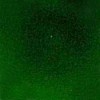
Infection assay
GFP and Alexa 488 fluoro remission
Variable microscopic magnification.
Green fluorescence.
Adherent cells (primary human fibroblasts) in 96-well micro plates. Fluorophores: DAPI and AlexaFluor488.
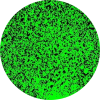
GFP/DAPI-expressed virus infected
"Using DNA recombinant technology, scientists combine the GFP gene to a another gene that produces a protein that they want to study, and then they insert the complex into a cell."
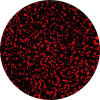
RFP-expressed virus infected
"Using DNA recombinant technology, scientists combine the GFP gene to a another gene that produces a protein that they want to study, and then they insert the complex into a cell."
[https://embryo.asu.edu/pages/green-fluorescent-protein but with RFP instead of GFP]

Unstained cells
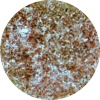
Alveolar epithelial cells (AEC)
"Typically, type 1 alveolar cells comprise the major gas exchange surface of the alveolus and are integral to the maintenance of the permeability barrier function of the alveolar membrane. Type 2 pneumocytesare the progenitors of type 1 cells and are responsible for surfactant production and homeostasis."
[https://www.sciencedirect.com/topics/medicine-and-dentistry/alveolar-type-i-cells]
The alveolar epithelium is a major target in toxic exposures of the lung because of its structural delicacy and proximity to inhaled toxicants. Type II epithelial cells are important in maintaining the integrity of alveolar epithelium and normal lung function.
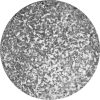
AEC graylevels
"Typically, type 1 alveolar cells comprise the major gas exchange surface of the alveolus and are integral to the maintenance of the permeability barrier function of the alveolar membrane. Type 2 pneumocytesare the progenitors of type 1 cells and are responsible for surfactant production and homeostasis."
[https://www.sciencedirect.com/topics/medicine-and-dentistry/alveolar-type-i-cells]
The alveolar epithelium is a major target in toxic exposures of the lung because of its structural delicacy and proximity to inhaled toxicants. Type II epithelial cells are important in maintaining the integrity of alveolar epithelium and normal lung function.

HCMV (Human cytomegalovirus): unstained
"The glycoprotein gO (UL74) of human cytomegalovirus (HCMV) forms a complex with gH/gL. Virus mutants with a deletion of gO show a defect in secondary envelopment with the consequence that virus spread is restricted to a cell-associated pathway."

MCMV mutants got generated that express with tdTomato, eGFP or mCherry
MCMV mutants, tdTomato, Cherry, eGFP fibroplasts

MCMV (Mouse Cytomegalovirus) unstained
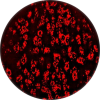
MCMV (Murine Cytomegalovirus) red fluoro remission.
"Cytomegalovirus (CMV) (from the Greek cyto-, "cell," and megalo-, "large") is a genus of viruses in the order Herpesvirales."

MCMV (Murine Cytomegalovirus) greenfluoro remission
"Cytomegalovirus (CMV) (from the Greek cyto-, "cell," and megalo-, "large") is a genus of viruses in the order Herpesvirales."
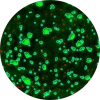
Mouse spleen cells mostly lymphocytes stained with FITC-conjugated anti mouse cd45 stain
"The spleen is an organ found in virtually all vertebrates. Similar in structure to a large lymph node, it acts primarily as a blood filter. A study published in 2009 using mice found that the red pulp of the spleen forms a reservoir that contains over half of the body's monocytes." [https://en.wikipedia.org/wiki/Spleen]
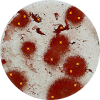
Foci assay: Very large Foci
"The focus forming assay (FFA) is a variation of the plaque assay, but instead of relying on cell lysis in order to detect plaque formation, the FFA employs immunostaining techniques using fluorescently labeled antibodies specific for a viral antigen to detect infected host cells and infectious virus particles before an actual plaque is formed."

Plaque assay extremely large spots
"The TCID50 (Median Tissue Culture Infectious Dose) is one of the methods used when verifying viral titer. TCID50 signifies the concentration at which 50% of the cells are infected when a test tube or well plate upon which cells have been cultured is inoculated with a diluted solution of viral fluid."

TCID50 viral assay
Cells were infected and covered with an overlay. Cells stained with CV survive. Unstained cells were killed by the virus.

CV Plaque assay.Example with large and fuzzy plaques
Cells were infected and covered with an overlay. Cells stained with CV survive. Unstained cells were killed by the virus.

Neutralization assay
"The plaque reduction neutralization test is used to quantify the titer of neutralizing antibodies for a virus. The serum sample or solution of antibodies to be tested is diluted and mixed with a viral suspension."
[https://en.wikipedia.org/wiki/Plaque_reduction_neutralization_test]
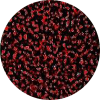
Detection of Marek's disease virus Plaques after staining with specific anti-MDV antibodies and Alexa 568 labelled secondary antibodies
"Marek's disease is a highly contagious viral neoplastic disease in chickens. The disease is characterized by the presence of T cell lymphoma as well as infiltration of nerves and organs by lymphocytes. Viruses related to MDV appear to be benign and can be used as vaccine strains to prevent Marek's disease."
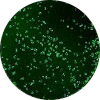
Detection of Marek's disease virus Plaques after staining with specific anti-MDV antibodies and Alexa 488 labelled secondary antibodies
"Marek's disease is a highly contagious viral neoplastic disease in chickens. The disease is characterized by the presence of T cell lymphoma as well as infiltration of nerves and organs by lymphocytes. Viruses related to MDV appear to be benign and can be used as vaccine strains to prevent Marek's disease."

Various colonies in 6 well plates and on 35 mm - 100 mm petridishes
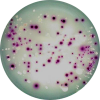
Various media/strain combinations on petridishes

AEC color
"Typically, type 1 alveolar cells comprise the major gas exchange surface of the alveolus and are integral to the maintenance of the permeability barrier function of the alveolar membrane. Type 2 pneumocytesare the progenitors of type 1 cells and are responsible for surfactant production and homeostasis."
[https://www.sciencedirect.com/topics/medicine-and-dentistry/alveolar-type-i-cells]
The alveolar epithelium is a major target in toxic exposures of the lung because of its structural delicacy and proximity to inhaled toxicants. Type II epithelial cells are important in maintaining the integrity of alveolar epithelium and normal lung function.
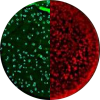
Adenovirus
"Adenoviruses (members of the family Adenoviridae) are medium-sized (90–100 nm), nonenveloped (without an outer lipid bilayer) viruses with an icosahedral nucleocapsid containing a double stranded DNA genome.
Their name derives from their initial isolation from human adenoids in 1953.
They have a broad range of vertebrate hosts; in humans, more than 50 distinct adenoviral serotypes have been found to cause a wide range of illnesses, from mild respiratory infections in young children (known as the common cold) to life-threatening multi-organ disease in people with a weakened immune system."

Antibiotic potency USP/PhEur/DIN/BP Petrishes
The antibiotic potency assay measures the effectiveness of an antibiotic by the degree of growth inhibition on susceptible strains of microorganisms at different concentrations.

GFP immunofluorescence on HEK 293 cells
"Human embryonic kidney 293 cells, also often referred to as HEK 293, HEK-293, 293 cells, are a specific cell line originally derived from human embryonic kidney cells grown in tissue culture."

Organoids
"An organoid is a miniaturized and simplified version of an organ produced in vitro in three dimensions that shows realistic micro-anatomy. The technique for growing organoids has rapidly improved since the early 2010s."

NK92 cells natural killer cells (human cell line) expressing green fluorescent protein (gfp)
"Natural killer cells, or NK cells, are a type of cytotoxic lymphocyte critical to the innate immune system. Typically, immune cells detect major histocompatibility complex (MHC) presented on infected cell surfaces, triggering cytokine release, causing lysis or apoptosis."

NK92 cells natural killer cells (human cell line) same samples microwell plate.
"Natural killer cells, or NK cells, are a type of cytotoxic lymphocyte critical to the innate immune system. Typically, immune cells detect major histocompatibility complex (MHC) presented on infected cell surfaces, triggering cytokine release, causing lysis or apoptosis."




